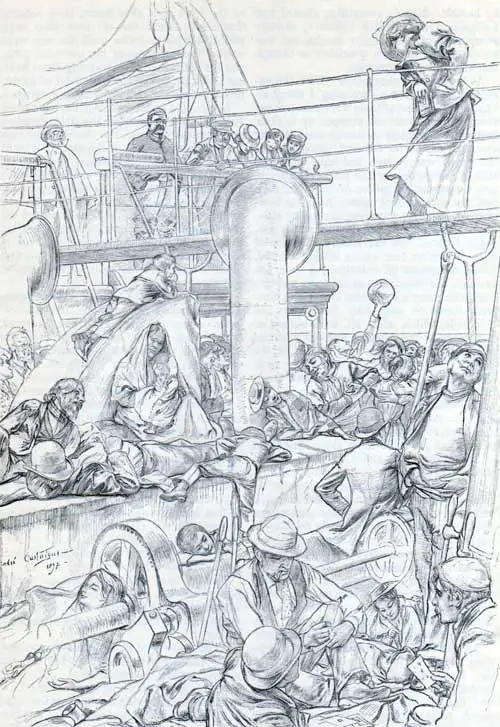The Influence of Sea Voyages Upon Women (1885)
None of the methods of treating illness by changing habits has received a higher approbation than a sea voyage. Yet the physiological basis for this kind of treatment has never been quite adequately explained.
It is challenging for anyone on board ship a, with previous or subsequent knowledge of his patients, to judge exactly what effect the sea influences have brought about, and a ship surgeon may only sometimes be the most skillful observer.

On the deck of a steamship circa 1890. Century Magazine, 1898. | GGA Image ID # 2182d05264
"We are delighted to notice a paper recently read by Dr. J. A. Irwin in New York, and now issued in the form of a pamphlet, which embodies his experience during the last six years, of which the greater part was spent at sea, and during which he had altogether fifteen thousand people in charge. He has confined himself to studying the genito-uterine functions and brings forward some conclusions worthy of attention. Many of the more considerable changes in life habits, such as diet, exercise, and sleep patterns, alter menstruation methods. This is especially the case during a sea voyage.
Dr. Irwin's research reveals a striking increase in discomfort and frequency of menstruation at sea. Interestingly, this phenomenon is less pronounced among steerage passengers, suggesting a correlation with susceptibility. He attributes these changes entirely to the motion of the vessel, which he believes leads to pelvic congestion. These findings underscore the significant impact of sea voyages on women's health, a topic of utmost importance in our field.
He throws in a pathological explanation of "the initial lesion," which " takes place within the semicircular canals of the internal ear, where the endolymph and the otoliths, following the irregular movements of the vessel, convey to the sensorium erroneous impressions of the position of the head in space." Such explanations are beyond the field of profitable study. Still, the facts seem well established by Dr. Irwin's observations and are recognized by such authorities as Dr. Fordyce Barker. Dr. T. G. Thomas, however, and Dr. Tyler Smith hardly agree. There is undoubtedly room for further observation, and "the initial lesion" may, for a time, be left in the background.
The second conclusion of Dr. Irwin is that seasickness tends to abortion or premature delivery. The sickness of kinetia, as he calls it, lays a very different result from the sickness of pregnancy and is dangerous for the early months and, to a lesser degree, for all except the sixth and seventh. Again, those who have studied the results of the Atlantic passage most carefully disagree with Dr. Trwip. The Stench writers all agree with him but have far less experience. The whole subject needs a broader collection of facts from which to draw any sure conclusions; as a step towards such a Collection, we feel indebted to Dr. Irwin's pamphlet.
"Influence of Sea-Voyaging Upon Women." The British Medical Journal, Volume 1, no. 1276 (1885): 1212.
